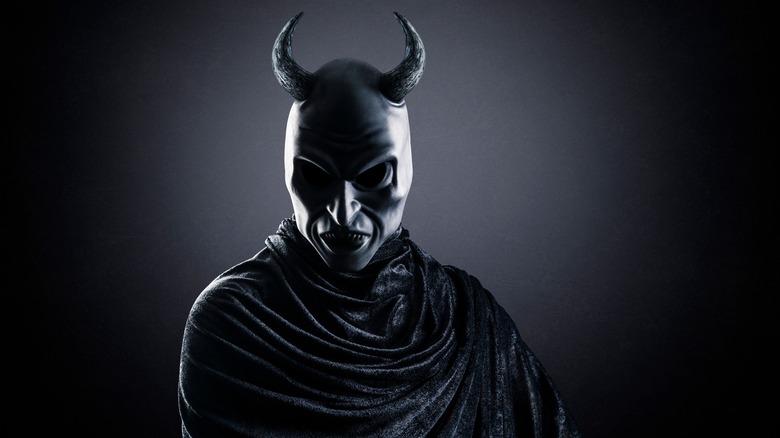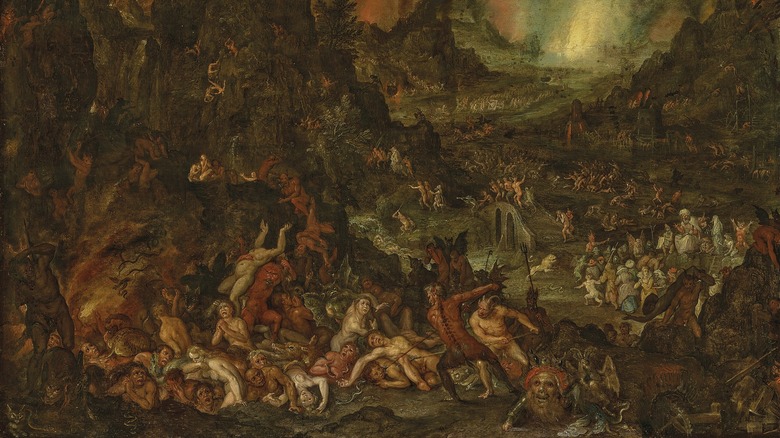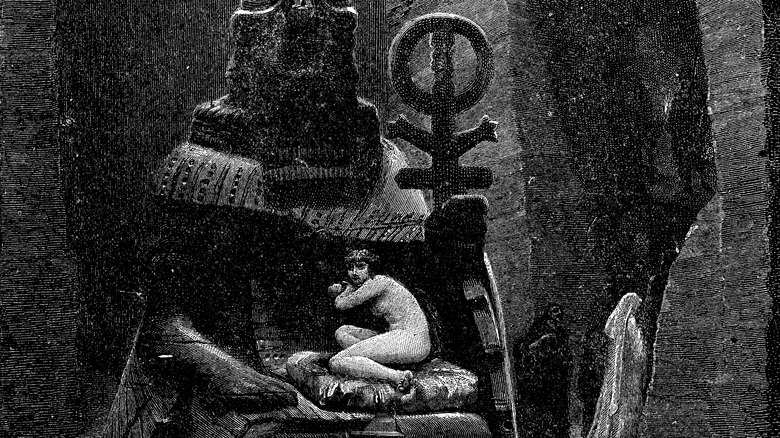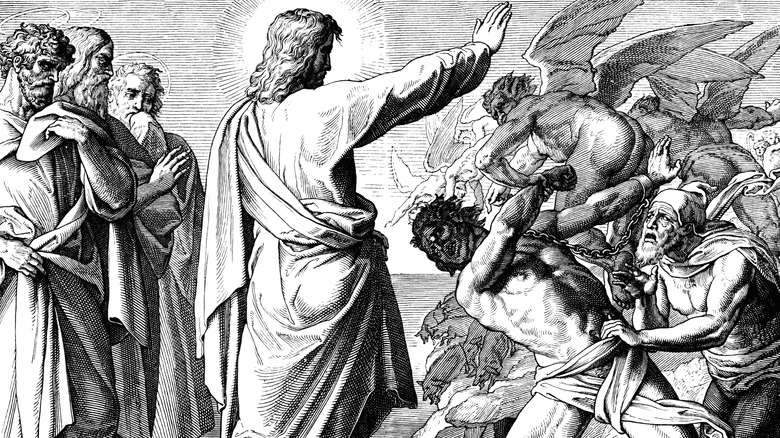The Four Most Disturbing Demons In The Bible
In Western, Christian countries the word "demon" will likely make people think of a monstrous humanoid figure with red skin, fire, horns, fangs, etc., and maybe a cavernous chamber of bloody torment. Then again, demons are also equated with intangible spirits and curses like in exorcism movies. And sometimes, a demon is a handsome dude with a posh English accent who lives in Los Angeles in that TV show, "Lucifer." But is Lucifer a demon, or a fallen angel? Are they the same? What about his minions? What are demons, actually?
All these questions are to say: There's a lot to unpack when it comes to "demons," biblical or otherwise, down to the word "demon" itself. There's a long history behind the very concept of demons — derived from "daimon" in Greek — dating back to ancient Rome, Greece, Babylon, Sumer, Akkad, Egypt, and every other ancient civilization. Every culture had its version of go-betweens for humanity and the gods, and evil trickster spirits who lead people astray.
The Bible describes its own demons, which in the Old Testament are more often called "evil spirits." None of them have names unless we classify non-Hebrew deities like Molech — a god associated with child sacrifice — as a demon. The Old Testament also mentions Satan, a generic term meaning "adversary" that later came to be associated with Lucifer of the New Testament. And then there's the multi-demon Legion from the Gospels and the recurring theme/character Abaddon, who plays a role in the Book of Revelation as the terrifying personification of "the abyss."
Demons then and now
If we really want to understand biblical demons beyond modern, media-fashioned cartoon imagery like in the "Diablo" video game series, we've got to look at what words like "demon" meant to the people who wrote the Bible, not us. And truth be told, demons aren't a big part of the Good Book. Like a lot of other points of doctrine, demonic entities, their prominence, role, etc., developed over centuries.
Medieval Catholicism first connected "demons" with the Bible's "fallen angels," as an article from the University of Reading explains. Theologians wanted a way to explain both the physical and spiritual nature of demons, portray them as actively involved in everyday human life, and went so far as to invent classifications of demons that we take for granted, like the "seven deadly sins," each of which has an insidious entity who incites and embodies it. St. Thomas Aquinas' ultra-influential "Summa Theologica" (written roughly between 1265 and 1274 C.E.) summarizes much of these changes, and even extends definitions of demons to creatures from folklore like incubi and succubae.
Those writing the Bible, however, had none of this in mind when talking about concepts or entities like Molech, Lucifer, Abaddon, Legion, or whatever else. To the ancient Hebrews of the Old Testament, who followed practical religious rites grounded in physical actions like animal sacrifices, a deity like the Canaanite god Molech was just "not Yahweh." To early Christian writers of the New Testament, demons were more unseen entities influencing human behavior.
[Featured image by Jan Brueghel the Elder via Wikimedia Commons | Cropped and scaled]
A Baal or Molech by any other name
To the ancient Hebrews, Molech (or Moloch) was the god of the Canaanite tribespeople next door. Some scholars believe he is Baal in the Bible's Old Testament, a generic term meaning "Lord." Much of what we know about Molech comes to us from the Bible, which isn't exactly going to paint Molech/Baal in any kind of flattering light. It's well-known that the Hebrew deity of the Old Testament wasn't too happy with Hebrews who gave attention to other gods. Deuteronomy 32 in part reads: "They made him [Yahweh] jealous with strange gods, with abhorrent things they provoked him. They sacrificed to demons, not God, to deities they had never known, to new ones recently arrived, whom your ancestors had not feared." Bear in mind that this is one of only three times that the word "demon" comes up in the Old Testament.
As for what Molech did or was, we have to rely on scholarly connections made between biblical passages, as the Jewish Virtual Library explains. Deuteronomy mentions, "passing [one's] son or daughter through fire," as does II Kings. Leviticus mentions passing children to Moloch, and II Kings again talks about "passing [one's] son or daughter through fire to Moloch." Other passages talk about sacrificing children to Baal, connect Baal to Molech, and also link child sacrifice with idols in Canaan. All in all, it seems like worship of Molech possibly involved literally throwing children into fire for sacrificial purposes.
We are Legion
Next up we've got one of the most well-known and straightforward demon stories from the New Testament books of Mark and Luke. This story sets the precedent for each and every exorcism ritual and tale to follow, all the way to the present.
As the tale goes, Jesus once came across a man variously described as "demon-possessed" and having "an impure spirit" in a region called Gerasenes. The man was chained and kept under guard, and the demons inside of him made him so strong that he broke his restraints. When Jesus asked the man his name — or rather, the demons inside of him — the demons called themselves "Legion" because, presumably, there were a lot of them packed in together. Then, Jesus transferred Legion out of the man and into a herd of nearby pigs, who went mad and ran into a lake and drowned. Mark, specifically, mentions that there were 2,000 pigs in the herd, although there's no mention of how many demons were in the man.
Like the other demons described in this article, there's no physical description of Legion — any ideas that people have about the appearance of demons come from artwork after the fact. Also, there's no further information on how Legion connects to infernal activities on the whole, where Legion came from, or anything like that. In fact, strictly speaking, Legion is the only entity in the entire Bible clearly identified both as a demonic and given a name.
Fall of the Day Star
And so we come to the most well-known — and complicated — demonic biblical character of them all: Lucifer. Or Satan. Or the devil. Over time these characters got compressed into one entity with one familiar narrative involving an angel who rebelled against god and rallied other angels to his cause before they all got tossed into hell, one day to be joined by non-Christians and tortured for eternity. In this narrative Satan is the chief demon amongst other demons.
Originally, though, "satan" wasn't a proper name like "George," but a common noun like "table." 1517 says that the common Hebrew noun is used 27 times in the Old Testament ("accuser/adversary"), and six times as a verb ("to accuse"). The English word "devil," deriving from the Greek word "diabolos," retains the same meaning of "accuser/slanderer." It took hundreds of years for a singular, all-encompassing "Satan" creature to arise in consciousness, particularly when Hebrews lived under 6th-century B.C.E. Persian influence.
To make matters more complex, the name "Lucifer" comes from the Latin word "lucifero" ("to shine") — from before the Bible was translated into Latin. This makes Lucifer a title meaning "day star." The title later got applied to the Old Testament Isiah story about Satan getting tossed from heaven: "How art thou fallen from heaven, O Lucifer, son of the morning!" By the time we get to the biblical book of Revelation written centuries later, we see Satan connected to the devil, and the great, big apocalyptic battle of good versus evil.
Into the abyss
Speaking of the Book of Revelation and the apocalypse: Abaddon. We mentioned earlier that Abaddon is a recurring character in the Bible. Like "satan," the word also began as a noun — "Abaddon" is mentioned six times in the Old Testament as Hebrew for "destruction." Destruction is simultaneously a concept, or an occurrence, and also a place. In Psalm 88, for instance, a person asks God, "Is your love declared in the grave, your faithfulness in Destruction?" Likewise, Job 31 says, "For that would have been wicked, a sin to be judged. It is a fire that burns to Destruction." Crosswalk tells us the latter use of "destruction" can also mean "the abyss," and it's this meaning that crops up again in Revelation.
In the poetic, creative, and admittedly sometimes horrifying Revelation, Abaddon — as both personification and now-named character — shows up in full force. Revelation 9 describes a time of darkness and torment when people longed to die amid locusts that "looked like horses prepared for battle." "On their heads they wore something like crowns of gold, and their faces resembled human faces," it continues. The locusts also have lion's teeth, women's hair, breastplates, scorpion stingers, and a king who presided over them: Abaddon, the "angel of the Abyss." Given the whole scene of death and pain in this passage of Revelation, it's not a stretch to equate the old Hebrew word for "destruction" with the destruction of "the abyss" facing humanity during its final days.





